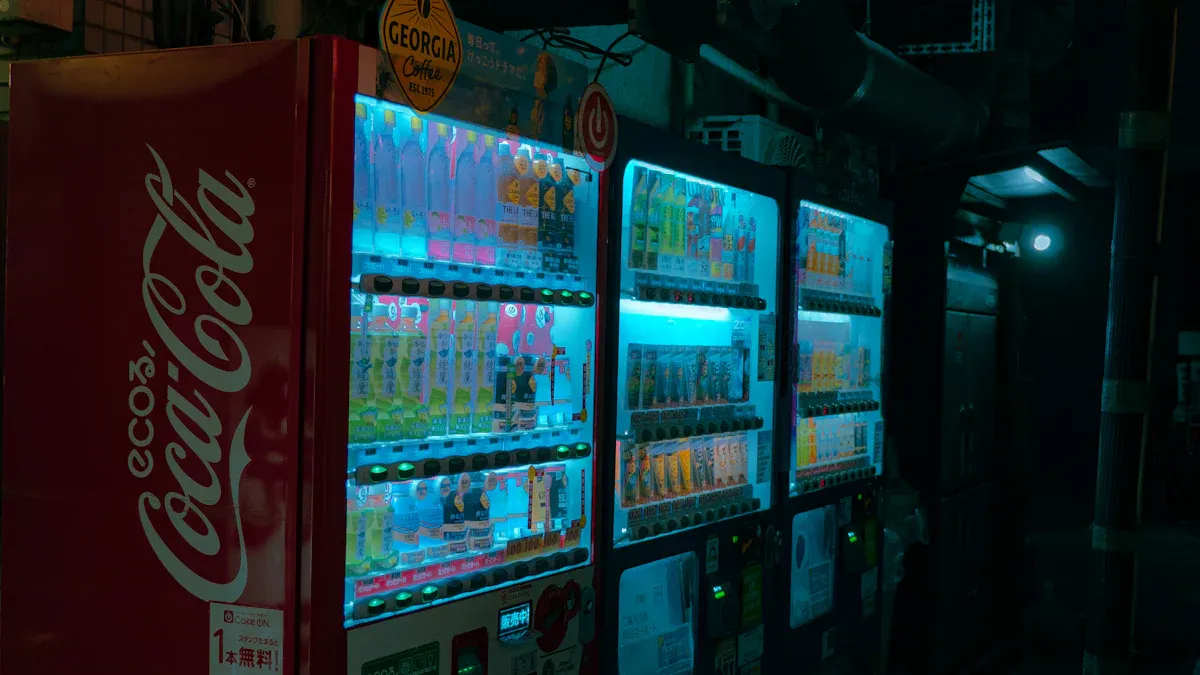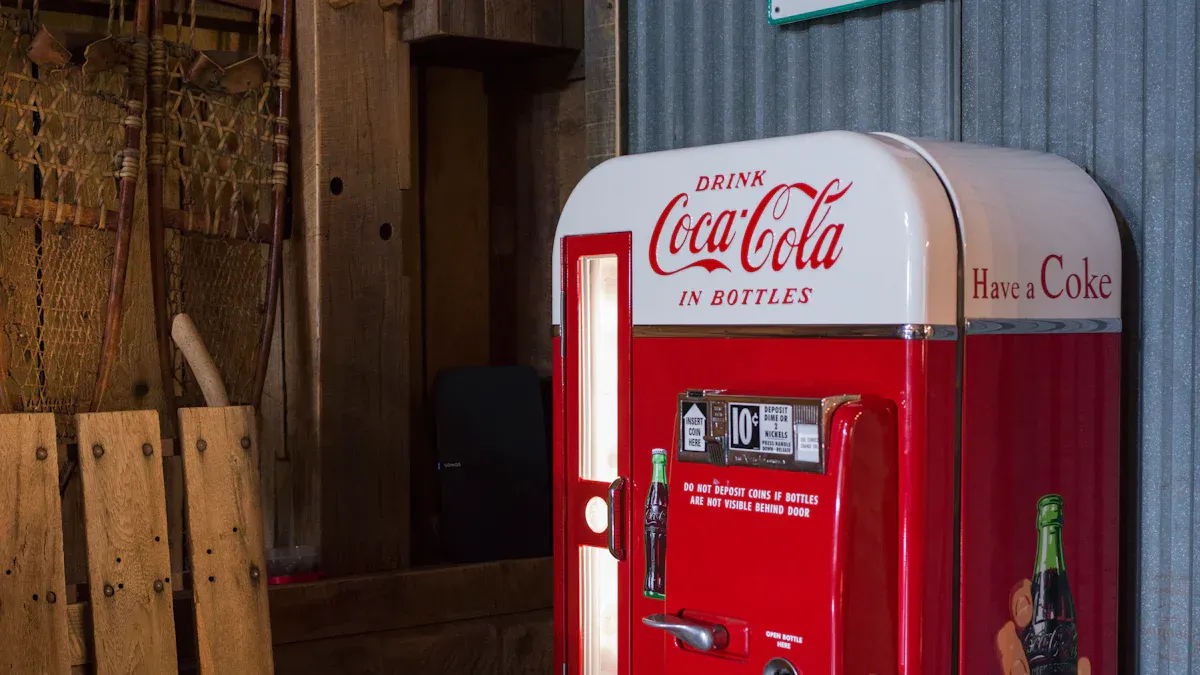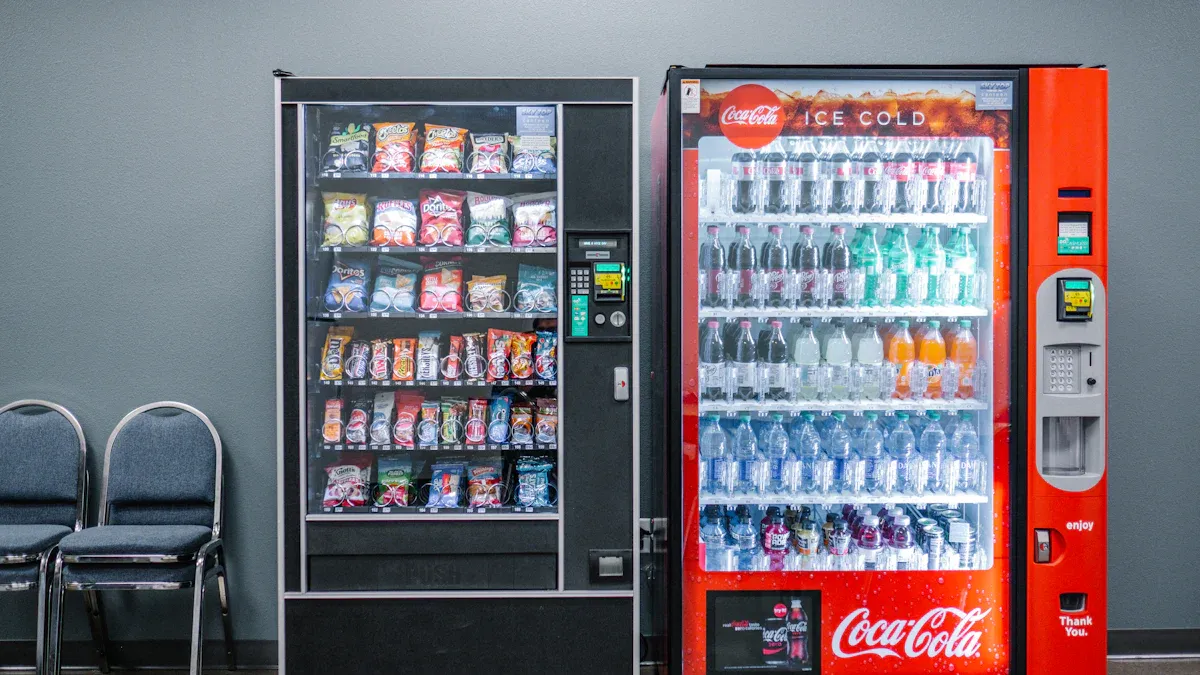The evolution of Coca-Cola Vending Machines from vintage to modern innovations

Coca-cola vending machines have changed a lot over time. Early versions used manual syrup urns, but today’s vending machines use smart technology. The coca-cola brand has always tried to improve the way people get drinks. These changes help the coca-cola company reach more people and make buying a drink easier. Vendo played a key role in making coca-cola vending machines popular. The coca-cola company continues to lead with new ideas in vending machines. People see how the coca-cola brand grows with each new machine. Vendo machines show how technology and design can shape the way people enjoy a drink. Vendo machines remain important in the story of the coca-cola company. Vendo keeps changing the way coca-cola vending machines work. Vendo machines remind everyone of the strong link between the coca-cola company and innovation.
Key Takeaways
Coca-Cola vending machines evolved from simple syrup urns to smart, high-tech machines that make buying drinks easy and fun.
Vendo played a major role by improving machine design, adding features like electric cooling, multi-drink options, and cashless payments.
Modern machines use AI, touchscreens, and internet connections to offer personalized choices and keep machines stocked efficiently.
Energy-saving parts and recycling features show Vendo’s commitment to protecting the environment while serving customers.
Vintage Vendo machines remain popular for their classic look and innovation, inspiring today’s advanced vending technology.
Coca-Cola Vending Machine Origins
Syrup Urn Beginnings
Vending machine history began with simple tools. In 1896, The Wheeling Pottery Company made porcelain syrup urns for Coca-Cola. These urns helped dealers who bought large amounts of syrup. The porcelain material looked clean at first, but it absorbed the syrup’s color over time. The urns changed from white to brown as they aged. This staining showed a clear limitation. Dealers saw the urns lose their bright look after many uses. Early vending machines did not exist yet, so people relied on these urns to serve beverages. The urns marked the first step in the journey of coca-cola vending machines.
Note: The original syrup urns became a symbol of early Coca-Cola service, even though they stained and aged quickly.
Icy-O and Early Designs
Vending machine history moved forward in the 1920s. The Icy-O machine appeared as one of the first mechanical vending machines. This design allowed people to get a cold drink without help from a server. The Icy-O machine used ice to keep bottles cool. People enjoyed the new experience of getting a cold Coca-Cola from a machine. The Icy-O machine made vending machines more popular and set the stage for future changes. Vendo later improved these early designs, making vending machines easier to use and more reliable. Vendo played a big part in shaping how people saw vending machines. Vendo’s focus on better technology helped the vending machine history move forward. Vendo also made sure that vending machines could serve more people in more places. Vendo’s work in this era started a long tradition of innovation in vending machines.
Vendo’s early efforts showed how important design and function are in vending machine history.
Vendo continued to lead as vending machines became a bigger part of daily life.
Vintage Vending Machines and Milestones

Vendo Company Innovations
Vendo shaped the story of vintage vending machines in many ways. The company started by making machines that could serve more people and offer a better selection. Vendo expanded its product line by acquiring Stoner Manufacturing. This move allowed Vendo to offer a full range of vending machines, which met the growing demand for more selection in public spaces. Harry Stoner, a respected leader, joined Vendo’s board and helped guide new ideas. Vendo engineers later developed the Lektro-Vend "FIFO" machine. This machine changed how vintage vending machines worked. It used a first-in, first-out system, which kept drinks fresh and made the selection process easier for users. The Lektro-Vend also had display windows, so people could see their selection before buying. The machine could hold mixed goods on one conveyor, which made it stand out from older machines. These changes set new standards for vintage vending machines and inspired other companies to improve their own designs.
Vendo’s focus on better selection and technology helped vintage vending machines become more reliable and user-friendly.
Vendo’s influence reached beyond its own products. The company’s engineers and leaders helped shape the entire vending machine industry. Many of the features seen in today’s drink vending machines started with Vendo’s early innovations. The company’s commitment to selection and quality made the vendo coca cola machine a favorite in many places.
1950s-1960s Expansion
The 1950s and 1960s marked a time of big growth for vintage vending machines. Vendo led the way by introducing new models that could offer a wider selection of drinks. The company launched the 1953 empty bottle strategy. This idea encouraged people to return empty bottles to the machine, which helped keep public spaces clean and made restocking easier. Vendo also introduced multi-drink machines during this period. These machines allowed users to choose from a selection of different sodas, not just Coca-Cola. The multi-drink feature became very popular and changed how people thought about vintage vending machines.
Vendo’s machines appeared in schools, factories, and public buildings. The company made sure each vendo coca cola machine could handle a large selection of drinks. This made the machines more useful and increased their popularity. Multi-drink machines gave people more choices and helped Vendo reach new customers. The company’s focus on selection and convenience set it apart from other makers of vintage drinks machines.
Tip: The empty bottle strategy not only helped the environment but also made the selection process smoother for users.
Iconic Vintage Models
Many vintage vending machines from this era became iconic because of their unique design and features. Collectors often look for models that offer a wide selection and have the classic Vendo look. The Vendo 81 is one of the most famous vintage drinks machines. It could hold several types of Coca-Cola bottles and offered a multi-drink selection. The machine’s bright colors and rounded edges made it stand out. People loved the way the vendo coca cola machine looked in diners and gas stations.
Other vintage models, like the Vendo 44 and Vendo 56, also became popular. These machines offered a selection of drinks and had easy-to-use coin mechanisms. The design of these vintage vending machines made them easy to spot and fun to use. Many collectors value these machines for their history and their role in bringing multi-drink options to the public.
Model | Year Introduced | Notable Feature | Selection Capacity |
|---|---|---|---|
Vendo 81 | 1955 | Multi-drink selection | 81 bottles |
Vendo 44 | 1956 | Compact design | 44 bottles |
Vendo 56 | 1957 | Large selection window | 56 bottles |
Vintage vending machines from Vendo remain popular with collectors and fans of vintage design. The machines’ focus on selection, multi-drink options, and eye-catching looks helped them become a lasting part of Coca-Cola history.
Coca Cola Machine History: Evolution and Technology
Electric Vending Machines
Coca cola machine history shows a big change when electric vending machines appeared. Before electricity, vendo machines used simple mechanics and ice to keep drinks cold. When electric power became common, vendo engineers designed machines that could cool drinks faster and more evenly. This new technology made the selection of cold drinks more reliable. People could trust that every bottle from a vendo machine would be cold and fresh.
Vendo used electric motors and compressors to improve the cooling process. These machines worked better in busy places like schools and factories. The selection of drinks grew because electric machines could hold more bottles and keep them at the right temperature. Vendo also made machines that could serve a multi-drink selection, giving people more choices. Electric vending machines helped coca cola machine history move forward by making it easier to offer a wide selection in many locations.
Electric vending machines marked a turning point in coca cola machine history. They made the selection process faster and more dependable for everyone.
Cashless and Electronic Features
Coca cola machine history continued to advance with the rise of electronic features. Vendo engineers added digital displays to their machines. These displays made the selection process easier and more fun. Customers could see all the drinks available and get recommendations based on their choices. The digital screens also helped people compare products before making a selection.
Vendo machines started to accept cashless payment options like Apple Pay and Google Wallet. This change made buying a drink faster and safer. People no longer needed to carry coins or bills. The electronic features also included telemetry systems. These systems sent real-time data to operators. They could see which drinks sold the most and which selections needed restocking. This information helped vendo improve inventory management and reduce waste.
Interactive digital displays increased user engagement by making the selection process simple.
Telemetry gave vendo operators insights into customer preferences and sales trends.
Cashless payment options made transactions quick and secure.
Vendo used these electronic features to boost sales and customer satisfaction. The machines looked modern and trustworthy. Branding became easier because digital displays could show ads and special offers. Vendo machines with electronic features set new standards in coca cola machine history.
Product and Packaging Changes
Coca cola machine history also includes many changes in product offerings and packaging. Vendo machines adapted to these changes by offering a wider selection of drinks and packaging types. Early machines only served glass bottles, but new packaging options appeared over time. Vendo engineers made sure their machines could handle cans, plastic bottles, and different sizes.
The table below shows how product offerings and packaging evolved in coca cola machine history:
Time Period | Major Changes in Product Offerings and Packaging Related to Vending Machines and General Availability |
|---|---|
1916 | Introduction of the iconic contour bottle to distinguish Coca-Cola from imitators. |
1920s | Shift from fountain sales to bottling; introduction of six-bottle cartons (1923); open-top metal coolers emerge as precursors to automated vending machines. |
1950s | Packaging innovations including multiple bottle sizes (6.5 oz, 10 oz, 12 oz, 26 oz) and introduction of cans (generally available by 1960). Consumers gained more packaging choices. |
1960s | Expansion of product range with new brands like Sprite®, Minute Maid®, Fresca®, and TaB®. |
1970s-1990s | Further brand additions including Mr. Pibb®, Mello Yello®, diet Coke®, Cherry Coke®, POWERADE®, and DASANI®. |
Vendo machines responded to these changes by increasing the selection of drinks. Multi-drink machines became more common. People could choose from sodas, juices, and water. Vendo engineers designed machines that could hold different bottle shapes and sizes. This flexibility made vendo machines popular in many places.
Note: The ability to offer a multi-drink selection helped vendo machines stay ahead in coca cola machine history. People enjoyed having more choices and new packaging options.
Vendo’s focus on selection, technology, and packaging changes shaped coca cola machine history. The company’s machines became known for their reliability and wide selection. Multi-drink options, cashless payment options, and electronic features made vendo machines a key part of coca cola machine history.
Modern Coca-Cola Vending Machines

AI and Smart Technology
Modern vending machines have changed how people buy drinks. Vendo uses artificial intelligence to improve the selection process. These machines can learn what customers like. They use data to suggest drinks based on past choices. Vendo adds interactive touchscreens to make the experience more fun. Customers can see all the options and get information about each drink. The selection becomes easier and faster. Vendo also uses smart sensors to check when drinks run low. This helps keep the selection fresh and full. Modern coca-cola vending machines show how technology can make buying a drink simple and smart.
IoT and Remote Monitoring
Vendo connects modern vending machines to the internet. This technology is called the Internet of Things (IoT). Operators can watch each machine from far away. They see which drinks sell the most and which selection needs restocking. Vendo uses this data to plan better routes for delivery. The machines send alerts if something goes wrong. This keeps the selection ready for customers. IoT helps vendo save time and money. Modern vending solutions use these tools to make sure every coca-cola vending machine works well.
Note: Remote monitoring lets vendo fix problems quickly and keep the selection fresh.
Sustainability Efforts
Vendo cares about the environment. Modern vending machines use less energy than older models. Vendo designs machines with eco-friendly parts. They use LED lights and better cooling systems. These changes lower power use and help the planet. Vendo also makes machines that can recycle bottles and cans. This supports green habits and keeps public spaces clean. Modern vending machines show how technology and care for the earth can work together. Vendo leads the way in making modern vending solutions that help both people and nature.
Feature | Benefit |
|---|---|
Energy-saving systems | Lower power use |
Recyclable materials | Less waste |
Smart cooling | Keeps selection fresh longer |
Modern coca-cola vending machines reflect bigger trends in vending machines. People want smart, green, and easy-to-use machines. Vendo meets these needs with modern vending machines that offer a wide selection and use the latest technology.
Coca-Cola Vending Machine Evolution and Impact
Cultural and Technological Shifts
The coca-cola vending machine evolution reflects major changes in both culture and technology. Early machines, like the vintage vending machines from the 1940s and 1950s, became symbols of American life. People gathered around these machines in schools, factories, and public places. The bright colors and unique designs made each vendo model an iconic cultural touchstone. These machines did more than sell drinks. They shaped how people connected with the coca-cola company and with each other.
Vendo engineers introduced new features over time. They added electric cooling, digital displays, and cashless payments. Each improvement made the machines easier to use. The coca-cola company used these changes to reach more people. Vendo machines started to appear in airports, malls, and even on city streets. The machines adapted to new packaging, offering cans and bottles of different sizes. This flexibility helped vendo stay ahead as technology changed.
Note: Vintage vending machines still attract collectors and fans today. Their design and function remind people of past eras and changing lifestyles.
Influence on the Vending Machines Industry
Vendo has set many standards for the vending industry. The company’s focus on technology and user experience pushed other makers to improve their own machines. Vendo introduced interactive features that changed how people use vending machines. For example, the coca-cola company worked with Snapchat to add augmented reality (AR) to some vendo machines. This made the machines more engaging and fun.
The AR-powered vendo machines increased average user interaction time to 90 seconds.
These machines generated over 40 million media impressions worldwide.
The project marked the world’s first AR-powered vending machine, setting a new benchmark for technology in the industry.
Vendo’s innovations inspired other companies to add smart features and digital displays. The coca-cola company showed that vending machines could be more than simple dispensers. They became platforms for advertising, entertainment, and brand connection. Vendo’s work helped make vintage vending machines and modern models important in daily life.
Vendo Innovation | Industry Impact |
|---|---|
AR-powered vending | Higher engagement, global reach |
Cashless payments | Faster, safer transactions |
Remote monitoring | Better service, less downtime |
Vendo continues to lead the way in vending technology. The company’s machines remain a model for others in the industry.
Coca-cola vending machines have changed a lot since the first syrup urns. The coca-cola brand used vendo machines to bring new ideas to people everywhere. Vendo made machines easier to use, smarter, and more fun. Vendo added electric cooling, digital screens, and cashless payments. Vendo also helped the machines use less energy. Vendo made sure people could choose from many drinks. Vendo used smart technology to keep drinks fresh. Vendo worked on recycling and green designs. Vendo led the way in making machines better. Vendo will shape the future of vending machines with new ideas and care for the planet.
FAQ
What makes vendo machines different from other vending machines?
Vendo machines stand out because they use advanced technology and smart features. These machines often offer a wide selection of drinks. Vendo focuses on making machines easy to use and reliable for everyone.
How did vendo improve the vending experience over time?
Vendo introduced electric cooling, digital displays, and cashless payments. These changes made the machines faster and more convenient. Vendo also added features like remote monitoring and smart sensors to keep drinks fresh and available.
Are vendo machines energy efficient?
Yes, vendo machines use energy-saving systems and eco-friendly parts. Vendo designs machines with LED lights and better cooling. These features help reduce power use and support sustainability.
Can vendo machines offer more than just Coca-Cola?
Vendo machines can serve many types of drinks. They handle cans, bottles, and different sizes. Vendo engineers make sure the machines can offer a wide selection, including sodas, juices, and water.
Why do collectors value vintage vendo machines?
Collectors like vintage vendo machines for their unique designs and history. Many models, such as the Vendo 81, became icons. Vendo machines remind people of past eras and show how vending technology has changed.
